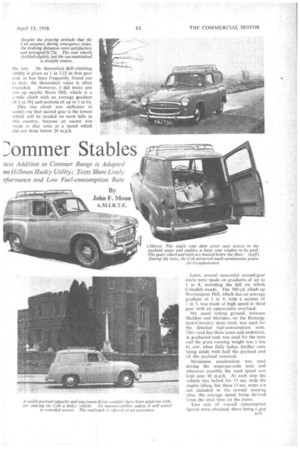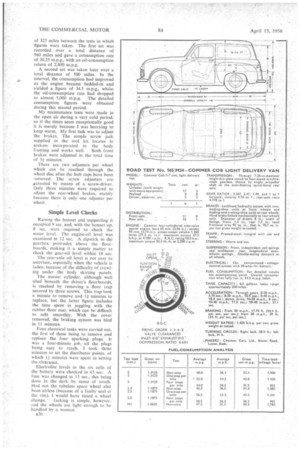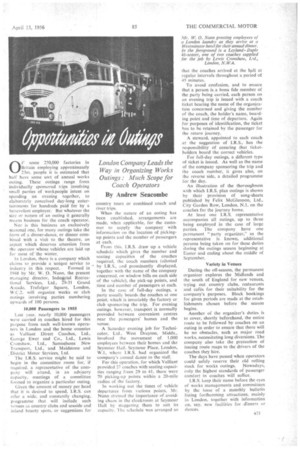A Cob from th :ommer Stables
Page 52

Page 53

Page 54

Page 55

If you've noticed an error in this article please click here to report it so we can fix it.
'WHEN the Hillman Husky was introduced by the Rootes V Group in October, 1954, it was offered as a double-duty utility vehicle capable of seating a driver and three passengers with a large amount of luggage, or a driver, a passenger and 5 cwt. of goods. From the onset it proved popular with tradesmen, farmers and others. It was often used solely as a load carrier, so it is not surprising that a version of the Husky, known as the Cob, has now been introduced into the C.ommer range.
The van, which is retailed at a basic price of £380 (in primer). plus £61 ps. 7d. purchase tax, has no specifically defined payload capacity, the rating being governed by the maximum gross vehicle weight recommended by Commer Cars, Ltd. This is 251 cwt., which allows a payload of up to 7 cwt. when none of the optional extras and accessories is fitted. Even with them the payload rating is still 5 cwt.
Payload Capacity 56 cu. ft.
Useful space in the body is 56 cu: ft. and there is an additional 10 cu. ft. available alongside the driver when thepassenger seat is omitted. Two cornpartments belOw the front of the false floor can be used-for small parcels.
Despite its length of 12 ft. 2 in. and width of -5 ft 31 in., the Cob is quite capacious and its small size and good turning circle impart to it a standard of manoeuvrability such . as is rarely obtained in even the lightest of delivery vans.
All-steel integral construction is employed for the body and underframe, producing a solid assembly which was found on test to be commendably free from drumming and rattles. The underframing is carried forward from the scuttle to form a supporting cradle for the power unit and mounting members for the front suspension units. An alligator-type bonnet provides good engine accessibility.
Single Rear Door
The door on each side of the driver's compartment has a winding window and swivelling quarter vent. A single rear door has given the manufacturers the chance to incorporate a really wide and useful window. A conventional locking handle is not fitted to the rear door, but a lockable press-button catch is incorporated in the near-side rear corner panel. When the button is pressed, the spring-loaded door opens about 5 in., from which position it can then be completely opened.
The 1.265-litre four-cylindered sidevalve petrol engine used in the Cob is _ basically the old Hillman Minx engine, and with its maximum output of 37.5 b.h.p. it gives a good power-toweight ratio which produces a high maximum speed, lively acceleration and useful hill-climbing abilities, The maximum torque of 55.5 lb.-ft. occurs • at 2,200 r.p,m. A 6.63 to 1 compression ratio is itsed and the crankshaft is carried in three white-metal-lined shelf . bearings.
is 18 On home models, the Zenith 30 V.N.7 carburetter carries a wire-gauze air cleaner and silencer, and on export vehicles an A.C. oil-bath cleaner is fitted. A mechanical fuel pump is used.
The engine is unit-mounted at three points with the four-speed synchromesh gearbox, the box having a conventional cranked lever in the centre of the -cab floor. The gear ratios are 3.567, 2.47, 1.49 and 1 to 1, with a reverse ratio of 4.76 to I.
An open propeller shaft with Hardy Spicer needle-roller universal joints connects the drive to the semi-floating rear axle, which has spiral-bevel finaldrive gearing giving a ratio of 4.778 to 1. The rear suspension consists of longitudinal semi-elliptic springs assisted by double-acting dampers. The front
wheels are independently sprung on coil springs and double wishbones, doubleacting dampers also being incorporated.
Lockheed hydraulic braking is used, with two-leading-shoe units at the front wheels and leading and trailing shoes at the rear wheels. The combined master cylinder and reservoir is attached to the outside of the off-side main-framing member below the driver's footboard, where it can be easily reached for topping up.
Worm and nut steering gear, with a ratio of 15 to 1. requires 21 turns of the two-spoke wheel to take the front wheels from lock to lock. The standard tyres are tubeless 5.00-15 in.
As the results obtained during the test show, the Cob's performance leaves little to be desired and after over 1,000 miles on the road with the van, I am certain that it will be a best-seller.
As supplied for test, the Cob was equipped with several of the accessories and optional extras which are ,specified by the manufacturers. These included a passenger seat, roof rack, overriders, rim-finishers, towing-bar attachment end fresh-air heater.
These brought the kerb weight up to 17i cwt., compared with the "stripped" weight of 17 cwt. Allowing l cwt. for a passenger, the gross running weight, as tested, was equivalent to that of the vehicle with the driver alone and a 7-cwt. payload.
I was accompanied throughout the majority of the tests by a passenger, and several long runs were made with the full test load, plus an overload corn prising personal items. One such run was over a distance of 110 miles made at an average speed of 46 m.p.h.-admittedly on a Sunday morning when traffic was light.
The engine was quiet and the controls were generally light. The van had covered only 680 miles before my collecting it, but this was considered to be a sufficient distance to dispense with the running-in procedure. Therefore, I was quickly able to appreciate the liveliness of the vehicle.
Brake tests were conducted along. a quiet hard-surfaced road near Bartonin-the-Clay. Several emergency stops were made in each direction with remarkably consistent results. On each occasion full pedal pressure was used: but wheel-locking was not .unduly pronounced and there was no tendency to deviate from a straight course.
Average Deceleration 0.75g
The average rate of deceleration from each speed was approximately 0.75g, as obtained from the stopping-distance figures. The Tapley meter recorded an average maximum retardation figure of 90 per cent, efficiency, although at one time the meter registered 100 per cent., which would be due to the forward pitching of the van during heavy braking.
Emergency stops from 20 m.p.h. with the hand brake produced an average Tapley meter deceleration reading of 42.5 per cent., showing the brake to be a reliable stand-by for an emergency.
Acceleration figures recorded on the same stretch of road virtually speak for themselves. Rapid gear changes are possible because of the efficient baulktype synchromesh mechanism, and for all the standing-start tests the initial getaway was made in second gear. When making the direct-drive tests the engine and transmission produced no violent reactions as a result of accelerating from below 10 m.p.h. in top gear.'
There was no hill steep enough to put the gradient ability of the Cob fully to the test. Its theoretical thill-climbing ability is given as I in 3.22 in first gear and, as has been frequently found out in tests, the theoretical value is often exceeded. However, I did make one run up nearby, Bison Hill, which is a climb with an average gradient of 1 in 101 and -sections of up to 1 in 6+.
This one climb was sufficient to satisfy me that second gear is the lowest which will be needed on most hills in• this country, because an ascent was made in that ratio at a speed which did not drop below 20 mph. • Later, several successful second-gear starts were made on gradients; of up to I in 8, including the hill on which Coleshill stands. The 300-yd. climb up Warmington Hill, which has an average gradient of I in 9, with a section of 1 in 7, was made at high speed in third gear with an appreciable overload.
My usual testing ground, between Sheldon and Meriden, on the Birmingham-Coventry main road, was used for the detailed fuel-consumption tests. This road has three lanes and undulates. A .iw.a.cluated tank was used for the tests and the gross running weight was 1 ton 61 cwt. when fully laden, further runs being made with half the payload and all the payload removed.
Maximum acceleration was used during the stops-per-mile tests and wherever possible the road speed was kept near 40 m.p.h. At each stop the vehicle was halted for 15 sec. with the engine idling, but these 15-sec. stops are not included in the overall running time, the average speed being derived from the total time on the move.
Two sets of overall consumption figures were obtained, there being a gap B19 of 325 miles between the tests in which figures were taken. The first set was recorded over a total distance of 560 miles and gave a consumption rate of 30.25 m.p.g., with an oil-consumption return of 2,400 m.p.g.
A second set was taken later over a total distance of 500 miles. In the interval, the consumption had improved as the engine became bedded-in and yielded a figure of 34.5 m.p.g., whilst the oil-consumption rate had dropped to almost 5,000 m.p.g. The detailed consumption figures were obtained during this second period.
My maintenance tests were made in the open air during a very cold period, so if the times seem exceptionally good it is merely because I was hurrying to keep warm. My first task was to adjust the brakes. The simple screw jack supplied in the tool kit locates in sockets incorporated in the body framing and works well. Both front brakes were adjusted in the total time of 34 minutes.
There are two adjusters per wheel which can be reached through the wheel disc after the hub caps have been removed. The screw adjusters are iictuated by means of a screw-driver. Only three minutes were required to adjust the rear-wheel brakes, mainly because there is only one adjuster per wheel.
Simple Level Checks
Raising the bonnet and supporting it occupied 9 sec, and, with the bonnet up, 8 sec. were required to check the water level. The engine-oil level was examined in 12 sec. A dipstick in the gearbox protrudes above the floorboards, making it a simple matter to check the gear-oil level within 18 sec.
The rear-axle ail level is not easy to ascertain, especially when the vehicle is laden, because of the difficulty of crawling under the body skirting panels.
The master cylinder, although well sited beneath the driver's floorboards, is reached by removing a floor trap secured by three screws. This trap took a minute to remove and 14 minutes to replace, but the latter figure includes the time spent in juggling with the rubber floor mat, which can be difficult to refit smoothly. With the cover removed, the braking system was bled in 11 minutes.
Four electrical tasks were carried out, the first of these being to remove and replace the four, sparking plugs. It was a four-minute job, all the plugs being easy to reach. I took three minutes to set the distributor points, of which 1+ minutes were spent in setting the clearance.
Electrolite levels in the six cells of the battery were checked in 45 sec. A fuse was changed in 13 sec., this being done in the dark by sense of touch. Had not the tubeless spare wheel also been airless (because of a faulty seal at the rim), I would have timed a wheel change. • Jacking is simple, however, and the wheels are light enough to be handled by a woman.
B20
OF some 250,000 factories in Britain employing approximately 23m. people it is estimated that half have some sort of annual works outing. These outings range from individually sponsored trips involving small parties of work-people intent on spending an evening together, to elaborately conceived day-long entertainments for hundreds paid for by a benevolent employer. But whatever the size or nature of an outing it generally means business for the coach operator.
Nor is this business an exclusively seasonal one, for many outings take the form of a dinner-dance, or dinner combined with a visit to the theatre, an aspect which deserves attention from the operator whose vehicles are laid up for most or the winter.
In London, there is a company which claims to provide a unique service to industry in this respect, , Formed in 1948 by Mr. W. o. Nunn, the present managing director, Indusgial Recreational Services, Ltd., 29-31 Grand Arcade, Trafalgar Square, London, Vt4.C.2, will organize works or club outings involving parties numbering upwards of 100 persons.
10,000 Passengers in 1955
Last year, nearly 10,000 passengers were carried in coaches hired for this purpose from such well-known operators in London and the home counties as Valliant Direct Coaches, Ltd., George Ewer and Co., Ltd., Lewis Cronshaw, Ltd., Samuelsons New Trans-port, Ltd., and Maidstone and , District Motor Services, Ltd.
The I.R.S. service might be said to begin in the committee room for, if required, a representative of the company will attend, in an advisory capacity. meetings of a comMittee formed to organize a particular outing.
Given the amount of money per head that it is desired to spend, I.R.S. can offer a wide, and constantly changing, programme that will include such venues as country clubs and seaside and inland beauty spots, or suggestions for
By Andrew Seacombe
country tours or combined coach and river trips.
When the nature of an outing has been established, arrangements are made, when applicable,, for the customer to supply the company with information oil the location of pickingup points and the number of passengers at each.
From this, I.R.S. draw up a vehicle schedule which gives the number and seating capacities of the coaches required, the coach numbers (allotted
by I.R.S.. and prominently displayed, together with the name of the company concerned, on window bills on each side of the vehicle), the pick-up points, and time and number of passengers at each.
In the case of full-day outings, a party usually boards the coaches at one point, which is invariably the factory or club sponsoring the trip. For evening outings. however, transport is normally provided between convenient centres near the passengers' homes and the venue.
A Saturday evening job for Technicolor, Ltd., West Drayton, Middx., involved the movement of 1,000 employees between their homes and the Seymour Hall. Seymour Place, London, W.1, where I.R.S. had organized the company's annual dance to the staff.
For this operation, for which Valliant provided 27 coaches with-seating capacities ranging from 29 to 41, there were 70 picking-up points within a 20-mile radius of the factory.
In working out the times of vehicle departures from various points, Mr. Nunn stressed the importance of _avoiding chaos in the cloakroom at Seymour Hall by staggering them to suit its capacity. The schedule was arranged so
Mr. W. 0. Nunn greeting employees of a London laundry as they arrive at a Westminster hotel for their annual dinner. In the foreground is a LeylandDuple 41-seater, one of two coaches supplied for the fob by Lewis Cronshaw, Lid.,
London, N. W.4.
that the coaches arrived at the hall at regular intervals throughout a period of 45 minutes.
To avoid confusion, and to ensure that a person is.a bona fide member of the party being carried, each person on an evening trip is issued with a coach ticket bearing the name of the organization concerned and giving the number of the coach, the holder's name, boarding point and time of departure. Again for purposes of identification, the ticket has to be retained by the passenger for the return journey.
A steward, appointed to each coach at the suggestion of I.R.S,, has the responsibility of ensuring that ticketholders board the correct vehicles.
For full-day outings, a different type of ticket is issued. As well as the name of the company sponsoring the trip and the coach number, it gives also, on the reverse side, a detailed programme for the day.
An illustration of the thoroughness with which I.R.S. plan outings is shown by their provision of. song-sheets published by Felix McGlennon, Ltd., City Garden Row, London, N.1, on the coaches for the journey home.
At least one I.R.S. representative accompanies all outings, up to three being employed in the case of large parties. The company have one permanent "party organizer," as the representative is known, additional persons being taken on for these duties during the outings season beginning at Easter and ending about the middle of September.
Variety in Venues During the off-season, the permanent organizer explores the Midlands and the south of England for new venues, trying out country clubs, restaurants and cafes for their suitability for the company's purposes. Block bookings for given periods are made at the establishments chosen before the season begins.
Another of the organizer's duties is to cover, shortly beforehand, the entire route to be followed by coaches on an outing in order to ensure that there will be no obstacles, such as major road works, necessitating long diversions. The company also take the precaution of issuing route maps to the drivers of the coaches they hire.
The days have passed when operators could safely reserve their old rolling stock for works outings. Nowadays, only the highest standards of passenger comfort in coaches will suffice.
I.R.S. keep their name before the eyes of works managements and, committees by the issue of a monthly bulletin listing forthcoming attractions, mainly in London, together with information on, say, new facilities for -dinners or dances.




















































































































